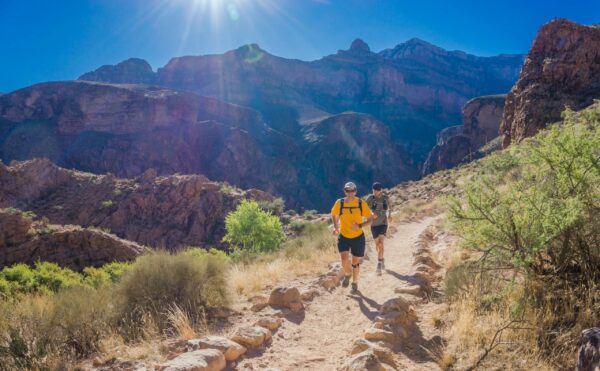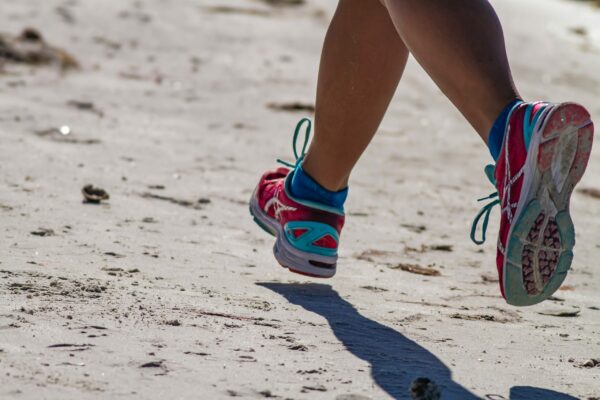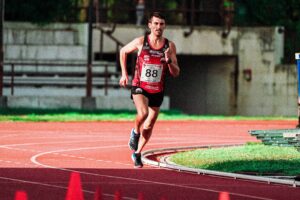Many exercisers want to become better runners and it’s great to have this kind of ambition giving progress, the benefits of regular running training, the health-promoting gains, and the joy of participating in public races. But how to run faster and longer with success is also about building a lasting foundation, such as keeping the body strong, starting at the right level, following a training program that fits into everyday life and maintaining motivation also on difficult days.

Start Running with Success
There are many benefits to running. You can e.g., train as you wish without rules. You can run alone or with training buddies, clear your mind or follow a personal program for certain distances in the future. Some of the more prominent benefits are:
- The calm of running alone with or without your thoughts (flow). Like a kind of therapy
- You get more energy and a stronger body. The training makes your body work more efficiently with increased metabolism and better fat combustion
- Running training provides a healthier lifestyle. Often you develop better sleep habits, quit smoking, and eat healthy food becomes more natural to choose
- Your body awareness gets better. You will find out which challenges your body is best to handle, especially under pressure by e.g., tempo training
- You gain more self-confidence and feel more comfortable when you are in good shape and you learn to achieve the goals of your training that also can inspire you in other areas of life
- As a runner, you are less exposed to depression. The body’s biochemistry optimizes and substances such as dopamine and endorphins are released more often and more efficiently
- Weight loss is also an excellent result of running training, which burns calories faster than any other activity
Run Faster And Longer – What Will You Achieve?

How to run faster and longer with success starts with goal setting. Therefore, it’s a good idea to think about what you want to achieve. Your training can be optimized by good planning and clear goals. So, set-up a goal that is challenging and inspiring but also realistic.
Goals give you something to move towards – you have made a priority. It gives your running training focus and structure that promotes your development as runner, gives you confidence, and motivates you to continue and set new goals in the future.
When you start running, you may think that a simple goal like “getting in shape” is appropriate, but it’s too vague. You need to specify a training level you want to achieve and how you want to measure it. Your goal should be structured. If you set many goals it is also fine but they should be developed and complement each other otherwise you risk being stressed and not being able to meet them all. Use the SMART model to test your goals.
The time frame and scope of your goals should also vary. Setting goals in the short, medium and long term will keep you motivated. When you e.g., train for a marathon, you will participate in races on shorter distances as 10, 15 and 20 km before the marathon race day. Short- and medium-term goals serve as milestones for your long-term goal and show you something about the training – does it work as it should?
Run Faster Longer With Variety
There are many opportunities to vary your running, avoid getting bored and stay motivated. Listen to music in your earbuds, run on hills, on other surfaces or on a treadmill. Stair running can also be a good option unless it gets too hard in relation to your goal.
The running surface has a great influence on how much load the body is exposed to when you run. It’s best to run on different surfaces, as it stimulates the body in all directions and thereby develops greater resilience. If you run on the same surface every time you run, you have a greater risk of getting overload injuries because the load becomes too one-sided. With varying terrain, you give the body different ‘inputs’ and as result, you become a more versatile and resilient runner ready to run faster and longer.

Pavements
This type of surface is one of the hardest to run on. But you are safe from cars and there is usually street lighting when it is dark. It provides good training to maneuver between pedestrians. You also have the opportunity to do interval training between the traffic lights or between the side roads. Choose a running shoe with high shock absorption.
Gravel roads
The shock absorption on this surface is relatively good and alternates between being with holes and being flat. It can vary a lot depending on the time of the year. The best type of running shoes for gravel roads is often with a rough pattern, which gives you a good take-off.
Asphalt
The shock absorption in the surface is very poor. But your foothold is optimal and you can get a good take-off. Your running abilities and skills are not challenged, so this surface is perfect for training where you want to think about other things than running.
Forest paths
The shock absorption in this surface is good but can also be muddy, with holes, filled with branches and other unexpected challenges. When the surface is constantly changing, great demands are placed on your attention, agility and reaction abilities, which are good qualities to train.
Beach

The shock absorption is optimal when you run in sand or directly on the beach and at the same time, it gives really good training for the stability of your ankles, knees and hips. The muscles in the feet are also going to work a lot. You should not run in the sand too often as it can cause overload injuries. On this type of surface, you can benefit by running in five-finger shoes.
Track and field
The shock absorption is really good and the surface is even. The surface seems very non-slip. Especially with spike shoes you really experience that you can run fast and safely but also how much it means with strong ankles, feet, and leg muscles. In 8 years, I ran intervals on this surface with the greatest pleasure because the difference in the feeling of ‘power’ and speed is so significant compared to all other surfaces.
Grass
The shock absorption is good and it seems like the longer the grass is the better shock absorption. With longer grass, you have to lift your feet higher to get forward, which gives good training of your hip abdomen and back muscles. Hidden holes and other irregularities become the challenge, but with good concentration, you get good running training. You can e.g., choose five-fingered glove shoes for this surface.
Treadmill
The shock absorption is really good, especially since the treadmill is resilient, so the landing phase is more gentle to the body. Many runners who cannot keep a high weekly kilometer amount without getting injuries use the treadmill to maintain the oxygen uptake and running style.
But it’s the surface of the treadmill that moves and it makes the running training different and may require a period to get used to in the beginning. But on the other hand, you can decide for yourself when a hill should come, and you can raise and lower the belt as needed. It is also easy to decide when you are home again. You can just stop the treadmill. There are other benefits as:
- It never rains and there is no wind
- You do not have to carry your water bottle yourself. It can stand in the ‘hole’ for the purpose on the shelf in the front together with your mobile phone.
- You can run next to a friend
- You can watch TV or listen to music
Running faster and longer

We could say that endurance training in ‘clear form’ is about being able to run far and for a long time. With anaerobic threshold training or lactate training, you will be able to run faster on the long runs. The anaerobic threshold describes the intensity at which the body can no longer get rid of the lactate as quickly as it is formed and your legs begin to ‘stiffen’.
But through training, this threshold can be moved so you can accumulate 3 – 6 times more lactate before your threshold is reached. When you move this threshold through training, you can thus maintain a higher speed for a longer time. Lactate threshold training is a hard form of training with high quality. This means that afterward, we need long restitution.
Tempo training, hill training and intervals or repetitions, are the best methods for lactate threshold training – moving the lactate threshold and thus running faster and longer. You will then become a stronger, faster and more confident runner.
Since lactate threshold training is a hard but effective training method, a weekly training session will be a good starting point no matter how fast you can run per kilometer. As soon as you are able to run 35 – 40 min. or more 3 – 4 times a week, you will be able to do one of your training sessions to tempo training.
It will not be easy the first time but you will quickly experience improvements. Your fitness will improve and your usual running training will be easier and more fun to complete.
Different types of tempo running
All types of tempo running – intervals – have periods of hard running and rest breaks. In addition to this, there are many variations you can perform such as performing intervals on a measured distance e.g., between traffic lights even though the exact distance is not crucial.
The rest breaks where you stand, walk, or jog can be varied depending on the purpose of the training. e.g., Short distances with long rest breaks are best for maintaining a high speed during the working periods while longer distances and shorter rest breaks are best for speed- and endurance training.
Intervals can e.g., be built-up as ‘pyramid training’ and look like this:
8x400m, 4x800m, 3x1200m or 400m, 800m, 1200m, 800m, 400m. You can also choose to run on time instead of distances like 8×90 seconds or 4×4 minutes.
As a rule of thumb, you perform tempo training when you exert yourself more than during your normal training. Once you get used to this training form, you should aim to run hard but evenly. Your last working interval should be as hard as the first and give you the feeling that you could not ‘give more’. In addition to improving your fitness a lot, you learn to run faster and longer as well as the value of pushing yourself.
Final Thoughts
As you can see it is relatively easy to run faster and longer but if it has to be a lasting success there are several criteria to consider. But when this is in place, you can get many good running experiences with a really good awareness of your own abilities, skills, what you are best at and what you want with your running training.
I hope you get something out of this post and if you have any questions about the topic or want to leave your own Personal review, please leave a comment below.
[faq-schema id=”3659″]






Great info, Many will find it very interesting. For me, I love to run with someone when am running, I get tired quickly if I am running alone. I agree with you, my son is a runner, training with a group. Any time he didn’t go running for a long time, it will slow him down a lot.
Hi Dozzy
Thank you for the comment. It can for many of us be a good idea with a “running buddy”, to keep up the energy and motivation.
Be Well
Hello there! This is an informative post! I always wanted to be able to run faster and for a longer period but I never really put in too much effort or thought in how I would do so other than to just keep doing it. That’s really cool that you included the different types of terrain for running with a description of each. Definitely creating variety in running habits will make it more motivating. Thanks for creating this info.
Hi Mike
Thank you for the comment. Yes, variety in running will make it more motivating but also make you more resilient and strong.
Be Well
I used to run, and I used to do 5 and 10ks. I find myself not running anymore but want to start again. It has been so long, I have quite honestly forgotten where to even begin. I am out of shape with the COVID restrictions and all. So where does one start if they want to pick up running again? There are so many benefits, I just need to figure out how to get going again.
Hi Leahrae
Thank you for the comment. You can still run alone, with a certain distance between a few others or with face covers https://shrsl.com/2uner. I run alone in the evening along the beachside or in the forest with no problems.
Be Well
I liked your article on running. What spoke to me was setting goals needed to be more specific than just getting in shape. If I am more specific, I have something definite to strive for.
I also liked your description of the different running surfaces. I was with a sense of humor that I read that you don’t need to run in the wind or rain when running on the treadmill. It does sound like the treadmill has a lot going for it.
Hi Carolyn
Thank you for the comment. True, when you set your own goals you will make progress on your terms. Running on a treadmill is a good alternative, but it can become ‘hot’ since there is no wind or rain to cool us down.
Be Well